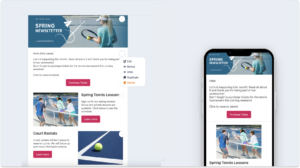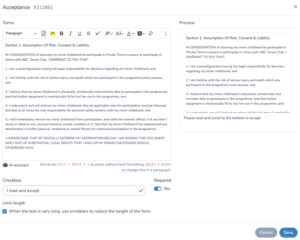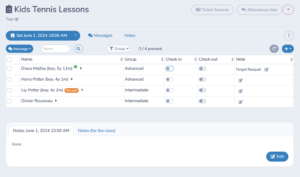
Starting a swim school is a venture that combines an entrepreneurial spirit with a passion for the sport. Below, we take a closer look at each step required to open a new tennis club.
We’ll discuss:
Step 1: Tennis Club Business Plan
Step 2: Find the Right Location
Step 3: Licenses and Insurance
Step 4: Attract and Hire Qualified Staff
Step 5: Market Your Tennis Club
Step 6: Use Technology to Enhance Your Operations
Step 7: Monitor and Adapt
Bonus: Other tools to help you grow a profitable Tennis Club
Author’s note: I’m Olivier and I share tips and tricks I’ve learned over the past decade as the owner of a children’s sports program. Today, as the co-founder of Activity Messenger, I help successful tennis clubs and academies across the U.S. and Canada streamline their operations, improve the way they communicate with members, and increase revenue.
A good business plan is the perfect place to start a new tennis club project. It should clearly define what you need to do to open your tennis facility:

Choosing the ideal location is crucial to grow a successful tennis club. Here are some options to consider when opening a new tennis club:
Minimize your initial investment by partnering with community centers, city parks, local schools, or facilities with existing tennis courts. This arrangement allows you to leverage the established audience and infrastructure of these venues, and eliminates the high costs associated with building and maintaining tennis courts. It’s important to negotiate terms that provide sufficient court hours and ensure the facility meets your program’s needs without disrupting the host’s schedule.

This option requires a greater financial commitment. However, it gives you complete control over the appearance, function and operation of the tennis courts. By customizing a facility specifically for your tennis club, you will be able to enhance the experience for your members. You may be able to offer more tennis lessons or special events than you could in a shared tennis facility. This option requires careful planning, from securing funding to designing a facility that is user-friendly and in compliance with all codes and regulations. With the freedom to customize everything from court surfaces and lighting to seating and accessibility, you can differentiate your tennis club in a competitive market. You’ll also have to consider extra costs such as real estate, local taxes, and court maintenance.

This option allows you to offer tennis lessons by traveling to your client’s location, such as private or community outdoor courts. It minimizes overhead costs because there is no tennis facility to maintain or rent. This model works well for clients who prefer the convenience of taking lessons in nearby parks. It also offers scheduling flexibility. However, it requires good logistical planning and effective local marketing to ensure a steady flow of customers. Mobile tennis lessons are ideal for those looking to enter the tennis market with a low initial investment. Once you have enough clients, you can start hiring other coaches to expand you operations.

Opening a tennis club franchise is a great way to get into the tennis teaching business. When considering the best franchise options, look for those that offer comprehensive support, including marketing assistance, operational training and a well-established curriculum. Brands such as Teddy Tennis Franchising, The Swing School, and TenTen Kids Sports are known for their structured programs and strong community presence. These franchises not only simplify the start-up process with turnkey solutions, but also provide ongoing support to franchisees in maintaining high standards of safety and instruction.
Regardless of the type of venue you choose, several factors are crucial when making your decision:
Careful consideration of these factors will provide a solid foundation for a successful tennis club or academy.
Compliance goes beyond meeting regulatory standards; it’s about building trust and credibility with your members. Here are the key compliance areas you need to consider when running a tennis academy:
Obtaining the appropriate business license from your local city or county is critical to legally operating a tennis club. Requirements may vary depending on your location, so check local government websites or offices to understand specific regulations. A business license ensures that you’re operating legally and helps build trust with your first customers.
Maintaining strict health and safety standards is essential for a tennis facility. This includes obtaining certifications that may require regular court maintenance, ensuring safe playing tennis courts, and having emergency response plans in place. Depending on your region, you may also need specific certifications for your coaches and staff. These certifications assure parents and players that your tennis academy is committed to their safety and well-being.

Proper insurance coverage is essential to protect your business and provide peace of mind for you and your clients.
This comprehensive coverage protects both your employees and your tennis club from unforeseen accidents.
Instructors are the cornerstone of any successful tennis club or academy. They have a direct impact on the quality of instruction and the overall experience of your members
Here’s how to ensure you have the right team in place:



Effectively marketing your tennis club requires a omni-channel approach to reach prospects and convert them into members. With the following marketing strategies, you can build awareness and drive conversions for your tennis programs.
Here’s are a few key marketing ideas for tennis clubs:


Search Engine Optimization (SEO) and Pay Per Click (PPC) Ads
For a more in-depth dive and additional ideas on how to market your tennis club, we’ve written a blog article: How to Improve Your Marketing for Tennis Clubs
Integrating technology into your tennis club can significantly improve operational efficiency and the overall customer experience.
An online platform like Activity Messenger can help your launch a successful tennis club:



Responding to both customer needs and the dynamics of the tennis marketplace is essential to operate a successful tennis club.
Here’s how you can manage these aspects effectively:

—————
Activity Messenger is a tennis club management software can help you get started with your plans to open and grow a new tennis club or academy.
It provides you with all the tools you need to succeed. Here are other ways we can help:
Sell tickets for your tennis tournaments
Best Tennis Quotes to inspire your members
Waitlist Management
——————
If you would like to learn more about Activity Messenger, book a demo with one our experts.